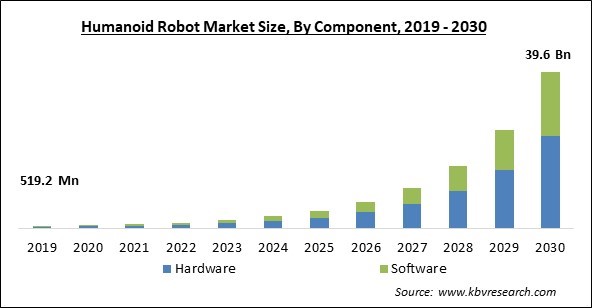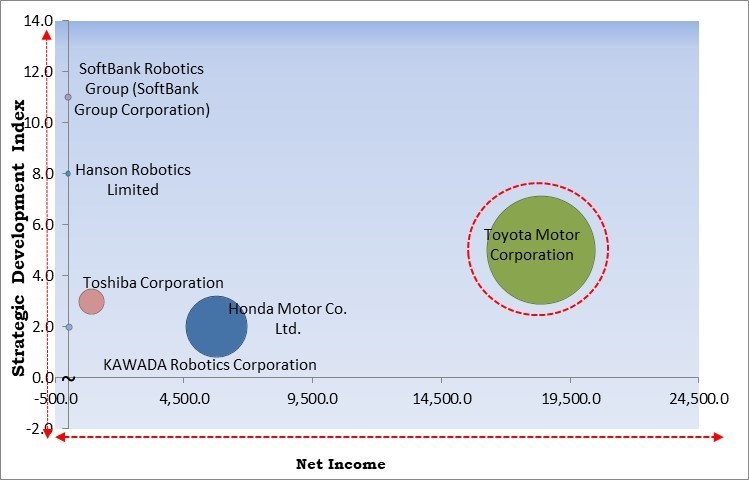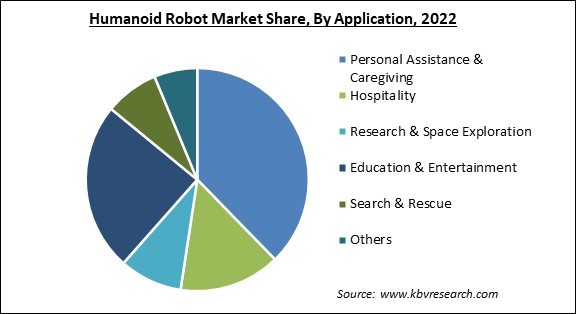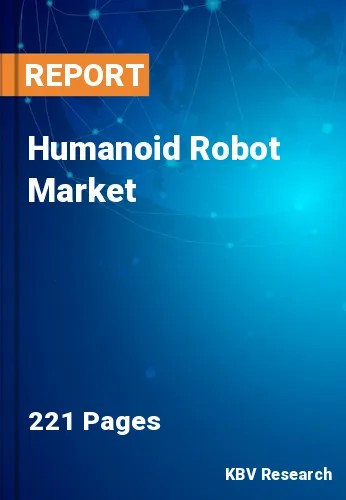The Global Humanoid Robot Market size is expected to reach $39.6 billion by 2030, rising at a market growth of 52.8% CAGR during the forecast period.
The personal assistance & caregiving is the major application of Humanoid robots as they are programmed to conduct the regular duties that carers are in charge of, like monitoring vital signs, giving medication, helping with feedings, and alerting medical personnel in an emergency. Therefore, the personal assistance & caregiving segment is expected to capture more than 35% share of the market by 2029. Humanoid robots are expected to become more popular as the population ages quickly in both developed and developing countries. WHO reports that one in six people will be 60 years of age or older by the year 2030. At this point, there will be 1.4 billion people, up from 1 billion in 2020, who are 60 years of age or older. The number of individuals 60 and older worldwide will double (to 2.1 billion) by 2050. Between 2020 and 2050, there will be 426 million more people who are 80 years of age or older than there are today.

The major strategies followed by the market participants are Partnerships as the key developmental strategy to keep pace with the changing demands of end users. For instance, In September, 2021, Honda Motor Co., Ltd. joined hands with Rakuten to run a trial robot delivery on the campus of the Ibaraki-based Uni. Additionally, the deployment of an automated vehicle built by Honda together with delivery boxes and systems developed by Rakuten. Moreover, In November, 2022, KAWADA Robotics Corp. teamed up with ExaWizards Inc. to solve social issues. Under this collaboration, both companies would develop exaBase Robotics Powder Weighing for NEXTAGE, a humanoid dual-arm robot. With NEXTAGE, the automation, and acceleration of powder weighing operations in the manufacturing sector through “NEXTAGE".
Based on the Analysis presented in the KBV Cardinal matrix; Toyota Motor Corporation is the major forerunner in the Humanoid Robot Market. In August, 2019, Toyota came into partnership with Preferred Networks for advancing useful service robots that could support people in daily life. Companies such as Hanson Robotics Limited, Honda Motor Co. Ltd. and SoftBank Robotics Group (SoftBank Group Corporation) are some of the key innovators in Humanoid Robot Market.

Robotics are in demand and are being used in a variety of applications as a result of technological breakthroughs. Humanoid robots offer the ideal interface for human-robot interactions as they can replicate a person. These are all results of advancing robotics research and ongoing technical development. Artificial intelligence, the creation of robot hardware, the implementation of bipedal or wheel drive locomotion, and human-robot interaction are the four key categories under which humanoid robot research is classified. These commercial developments are anticipated to help the market expansion of humanoid robots.
Humanoid robots can move fast in several directions and are incredibly mobile due to their four legs. Thus, humanoids are capable of carrying out a variety of human tasks both at home and at work. The behavior of these robots is intended to resemble that of humans. Accordingly, some robots are ideal for demanding industrial jobs, including deep-sea research, mining, and other heavy industries. In addition to operating machinery and vehicles, humanoid robots are utilized to care for the old and the sick. Numerous industry verticals make extensive use of humanoid robots. The market is anticipated to experience faster expansion as humanoid robot use rises in various key verticals.
Educational robots and programmable industrial or service robots are widely available on the market and manufactured with mass-market components. They come at a reasonable price and can handle simple tasks. The cost of research and development necessary to create humanoid robots, on the other hand, rises in direct proportion to the complexity of the jobs that they must perform. In controlled environments like factories and retail stores, robots have proven successful in operating and carrying out tasks. However, there is a growing need for robots to carry out advanced activities due to the growing need for service robots in several industries, including entertainment, education, search & rescue, public relations, logistics, cleaning, and medicine. As a result, the market growth may hinder due to the high initial cost of humanoid robots.
By application, the humanoid robot’s market is bifurcated into research & space exploration, education & entertainment, personal assistance & caregiving, hospitality, search & rescue, and others. The hospitality segment garnered a significant revenue share in the humanoid robots market in 2022. The hospitality sector is deploying robots to assist with customer care procedures, from artificial intelligence chatbots to auxiliary robots. Robots in hotels are employed to enhance the standard of guest satisfaction. Ordering has become simpler due to front desk robots. The deployment of robots in hotels and restaurants is advantageous since COVID-19's effects on the hospitality sector have made it necessary to prevent human-to-human contact and labor shortages.

Based on component, the humanoid robots market is classified into hardware and software. The hardware segment held the highest revenue share in the humanoid robots market in 2022. Humanoid robots can interact with people more effectively due to hardware components. A broader range of activities may be carried out by more complex robots with improved efficiency and accuracy because of developments in robotics engineering, materials science, and control system design. Hardware components, in particular, enhance humanoid robots' ability to interact with humans.
By motion type, the humanoid robot’s market is fragmented into biped and wheel drive. In 2022, the wheel drive segment dominated the humanoid robots market with the maximum revenue share. The wheel-drive robots are easy to construct and may be programmed to move with regard to the environment. Compared to two-legged robots, they are less likely to topple over since they can keep their balance on a solid foundation. At theme parks, science fairs, and amusement parks, wheel-drive humanoid robots are often used as entertainment. These elements are anticipated to fuel the demand for humanoid robots in the coming years.
| Report Attribute | Details |
|---|---|
| Market size value in 2022 | USD 1.4 Billion |
| Market size forecast in 2030 | USD 39.6 Billion |
| Base Year | 2022 |
| Historical Period | 2019 to 2021 |
| Forecast Period | 2023 to 2030 |
| Revenue Growth Rate | CAGR of 52.8% from 2023 to 2030 |
| Number of Pages | 221 |
| Number of Table | 362 |
| Report coverage | Market Trends, Revenue Estimation and Forecast, Segmentation Analysis, Regional and Country Breakdown, Competitive Landscape, Companies Strategic Developments, Company Profiling |
| Segments covered | Component, Motion Type, Application, Region |
| Country scope | US, Canada, Mexico, Germany, UK, France, Russia, Spain, Italy, China, Japan, India, South Korea, Singapore, Malaysia, Brazil, Argentina, UAE, Saudi Arabia, South Africa, Nigeria |
| Growth Drivers |
|
| Restraints |
|
Region wise, the humanoid robot’s market is analyzed across North America, Europe, Asia Pacific, LAMEA. In 2022, the North America region led the humanoid robots market by generating the highest revenue share. The development of humanoid robot technology and improved infrastructure is responsible for the market expansion. In North America, there is an increased demand for humanoid robots for teaching and providing care in the healthcare and educational sectors. The government and major businesses are boosting their investments, though, which is also fueling the market's growth in terms of income.
Free Valuable Insights: Global Humanoid Robot Market size to reach USD 39.6 Billion by 2030
The market research report covers the analysis of key stake holders of the market. Key companies profiled in the report include Hajime Research Institute, Ltd., Hanson Robotics Limited, Honda Motor Co. Ltd., HYULIM Robot Co., Ltd., KAWADA Robotics Corporation (Kawada Technologies Co., Ltd.), PAL ROBOTICS, SoftBank Robotics Group (SoftBank Group Corporation), Toshiba Corporation, Toyota Motor Corporation and Trossen Robotics.
By Component
By Application
By Motion Type
By Geography
The Market size is projected to reach USD 39.6 billion by 2030.
Highly flexible and mobile are driving the Market in coming years, however, High cost to be spent initially restraints the growth of the Market.
Hajime Research Institute, Ltd., Hanson Robotics Limited, Honda Motor Co. Ltd., HYULIM Robot Co., Ltd., KAWADA Robotics Corporation (Kawada Technologies Co., Ltd.), PAL ROBOTICS, SoftBank Robotics Group (SoftBank Group Corporation), Toshiba Corporation, Toyota Motor Corporation and Trossen Robotics.
The expected CAGR of this Market is 52.8% from 2023 to 2030.
The Personal Assistance & Caregiving segment is leading the Global Humanoid Robot Market by Application in 2022 thereby, achieving a market value of $9 billion by 2030.
The North America market dominated the Global Humanoid Robot Market by Region in 2022, and would continue to be a dominant market till 2030; thereby, achieving a market value of $13.2 billion by 2030.
Our team of dedicated experts can provide you with attractive expansion opportunities for your business.

